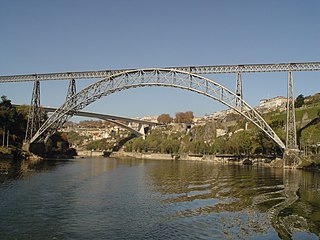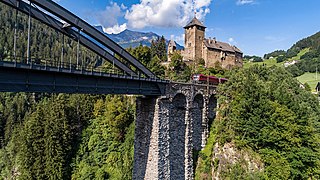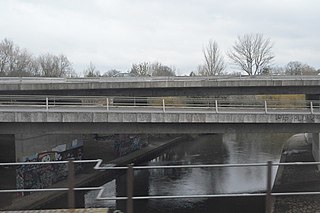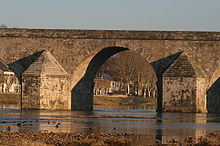
An arch bridge is a bridge with abutments at each end shaped as a curved arch. Arch bridges work by transferring the weight of the bridge and its loads partially into a horizontal thrust restrained by the abutments at either side. A viaduct may be made from a series of arches, although other more economical structures are typically used today.

The Millau Viaduct is a multispan cable-stayed bridge completed in 2004 across the gorge valley of the Tarn near Millau in the Aveyron department in the Occitanie Region, in Southern France. The design team was led by engineer Michel Virlogeux and English architect Norman Foster. As of October 2023, it is the tallest bridge in the world, having a structural height of 336.4 metres (1,104 ft).

A through arch bridge, also known as a through-type arch bridge, is a bridge that is made from materials such as steel or reinforced concrete, in which the base of an arch structure is below the deck but the top rises above it. It can either be lower bearing or mid-bearing. Thus, the deck is within the arch, and cables or beams that are in tension suspend the central part of the deck from the arch.

A concrete slab is a common structural element of modern buildings, consisting of a flat, horizontal surface made of cast concrete. Steel-reinforced slabs, typically between 100 and 500 mm thick, are most often used to construct floors and ceilings, while thinner mud slabs may be used for exterior paving (see below).

Formwork is molds into which concrete or similar materials are either precast or cast-in-place. In the context of concrete construction, the falsework supports the shuttering molds. In specialty applications formwork may be permanently incorporated into the final structure, adding insulation or helping reinforce the finished structure.

The Thomas Viaduct spans the Patapsco River and Patapsco Valley between Relay, Maryland and Elkridge, Maryland, USA. It was commissioned by the Baltimore and Ohio Railroad (B&O); built between July 4, 1833, and July 4, 1835; and named for Philip E. Thomas, the company's first president. Some claim it to be the world's oldest multiple arched stone railroad bridge. However, the Sankey Viaduct on the Liverpool and Manchester Railway was opened in 1830 and finally completed in 1833.

A girder bridge is a bridge that uses girders as the means of supporting its deck. The two most common types of modern steel girder bridges are plate and box.

The Isaac Lee Patterson Bridge, also known as the Rogue River Bridge and the Isaac Lee Patterson Memorial Bridge, is a concrete arch bridge that spans the Rogue River in Curry County, Oregon. The bridge was constructed by the Mercer Fraser Company of Eureka, California. The bridge carries U.S. Route 101 across the river, near the point where the river empties into the Pacific Ocean, and connects the towns of Gold Beach and Wedderburn. A bridge with strong Art Deco influences, the Isaac Lee Patterson Bridge is a prominent example of the designs of the Oregon bridge designer and highway engineer Conde McCullough. It was designated a National Historic Civil Engineering Landmark by the American Society of Civil Engineers in 1982. It is part of a series of notable bridges designed by McCullough for the Oregon Coast Highway in the 1930s. It was placed on the National Register of Historic Places in 2005.

The Maria Pia Bridge is a railway bridge built in 1877, and attributed to Gustave Eiffel, situated over the Portuguese northern municipalities of Porto and Vila Nova de Gaia.
This is an alphabetical list of articles pertaining specifically to structural engineering. For a broad overview of engineering, please see List of engineering topics. For biographies please see List of engineers.
Concrete cover, in reinforced concrete, is the least distance between the surface of embedded reinforcement and the outer surface of the concrete. The concrete cover depth can be measured with a cover meter. The purpose of concrete cover is to protect the reinforcement from corrosion, fire, and other potential damage.

The Godavari Arch Bridge is a bowstring-girder bridge that spans the Godavari River in Rajahmundry, India. It is the latest of the three bridges that span the Godavari river at Rajahmundry. The Havelock Bridge being the earliest, was built in 1897, and having served its full utility, was decommissioned in 1997. The second bridge known as the Godavari Bridge is a truss bridge and is India's third longest road-cum-rail bridge crossing a water body.

The Woodroad Viaduct, also known as Bank Viaduct or Templand Viaduct, is a viaduct carrying the Glasgow South Western Line over the Lugar Water at Cumnock in East Ayrshire, Scotland, United Kingdom. Since April 1971, it has been recognised as being a category A listed building.

The Yowaka River bridge is a heritage-listed road bridge that carries the Princes Highway across the Yowaka River at Greigs Flat, New South Wales, Australia. It was built in 1936. The bridge is also known as the Yowaka Bridge near Eden. The bridge is owned by Transport for NSW. It was added to the New South Wales State Heritage Register on 20 June 2000.

The Noirmoutier Bridge is a bridge located on the west coast of France in the department of Vendée, built in the early 1970s to connect the island of Noirmoutier to the mainland. Before it opened, a maritime shuttle service ran between the La Fosse pier on the island and Fromentine pier on the mainland.

The Trisanna Bridge is a 211-metre long viaduct carrying the Arlberg railway over the Trisanna river just southwest of Pians, a district of Landeck (Tyrol) in Austria. The bridge spans the Paznaun valley and Trisanna gorge, forming part of one of the most important east-west railway routes in the Alps.

The Loddon Bridge disaster was a collapse of falsework during construction of a reinforced concrete deck on the Loddon Bridge of the A329(M) motorway in Berkshire, England, on 24 October 1972. It killed three people and injured ten others. It is thought that a design error led part of the falsework, transitioning between the deck and the supporting towers, to be understrength and it failed by buckling or twisting. The part-poured deck fell into the river below. The collapse was investigated by Her Majesty's Factory Inspectorate and the contractor, Marples Ridgway pleaded guilty to a breach of the construction regulations at a trial in Bracknell, being fined £150.

The Crueize viaduct is a railway viaduct on the Béziers to Neussargues line, located in the commune of Saint-Léger-de-Peyre, in the Lozère département of France. It is nicknamed the "Viaduc de l'Enfer" after the valley it crosses.

The Gien viaduct is a railway bridge crossing the Loire at Gien in the Loiret and the Centre-Val de Loire region. It was part of the Gien - Argent railway line of which today only the Gien - Poilly-lez-Gien section is still in service, for the transport of goods.






















